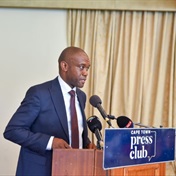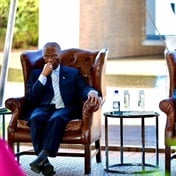
Sekhukhune: Greatest of the Pedi Kings
South African Heritage Publishers
48 pages, illustrated
R100
Early in 1876, various reasons were made up by the Boer authorities to attack King Sekhukhune and his people.
We are told that the incident that started the fighting happened when Dinkwanyane’s followers captured a wagon-load of wood belonging to a Boer called Jankowitz.
Apparently, he had trespassed on Dinkwanyane’s land to illegally cut the timber.
At the same time, the Boers spread rumours of cattle theft by the Bapedi. There was even a made-up story doing the rounds that Dinkwanyane had burnt down a German mission station belonging to the Reverend Nachtigal.
When this news, although false, reached Pretoria, an enraged President Thomas François Burgers decided to set out “to deal with the Sekhukhune menace himself”.
Burgers quickly assembled the largest army ever seen before in the Republic.
In the first war against Sekhukhune, Burgers’ army was armed with a few seven-pounders, or Krupp guns. They had a force of about 2 000 men and almost 500 wagons.
A strong force of Swazis joined the army. We have heard that the Swazis were brought into the fight by Mampuru, King Sekhukhune’s embittered brother.
They marched to Thaba Mosega, which they reached in July 1876. They were also supported by other African troops who were hoping the land under King Sekhukhune’s control would be given to them after he was defeated.
The Boers began by attacking Dinkwanyane and his followers. However, because King Sekhukhune had recognised him as one of the Bapedi chiefs, he immediately came to support his half-brother against the Boers.
Despite this help, the attack by the Afrikaners resulted in Dinkwanyane’s death. The battle was a bloody one.
The Boer, Joubert, and his men went to position themselves behind the Bapedi, but their progress was halted by the large numbers of the enemy who occupied the rocks, and Joubert returned to camp with his men.
For some unknown reason, there was no contact between Joubert and the other forces, probably because of the rough land and the distance.
As a result, the remaining Boers were unaware of Joubert’s failure. Although the Boers had reached the Bapedi and actually set fire to some of the huts, they were forced to withdraw, owing to lack of support from Joubert.
As a result, the Boers failed to dislodge King Sekhukhune. They returned from the scene of the action with some haste until they had recrossed the Steelpoort River.
For this reason, the First Sekhukhune War was often referred to as “die huis-toe oorlog”, the “go-home war”.
King Sekhukhune had inflicted an embarrassing defeat on the Boers and President Burgers. This defeat cost Burgers his position, and he lost the presidency to Paul Kruger.
In response to the bad defeat suffered by President Burgers, the Boers decided to pay an army of mercenaries or paid soldiers, called the Lydenburg Volunteer Corps, to go and attack King Sekhukhune.
Their leader was a reckless German adventurer from the diamond-mining world named Conrad Hans von Schlieckmann. He was a former officer and a soldier of fortune.
He was closely connected with the German government and had fought under Otto von Bismarck in the Franco-Prussian War of 1870 to 1871.
The mercenaries acted with the support of their home countries. Many of these soldiers of fortune were recruited from the diamond diggings in Kimberley, where they had gone in search of diamonds.
The Lydenburg area attracted them because it was said to hold large deposits of gold, diamonds and other precious minerals. So when Pretoria established the Lydenburg Volunteer Corps, Von Schlieckmann’s men, because they had not found any riches, joined willingly.
They fought fiercely from behind the defences to avenge the defeat of President Burgers. But they lost, and Von Schlieckmann himself was killed in battle in November 1876.
He was succeeded by an Irishman, Alfred Aylward. But this was not the end of the war. It was just the end of a battle - an important battle.
In the same month, King Sekhukhune attacked Fort Burgers. His aim was to recover the cattle he thought had been looted from the Bapedi by the colonial volunteers.
Although the Bapedi failed to take the fort, they recovered the cattle and killed two of the colonial volunteers.
The Boers’ policy was to trouble the Bapedi and prevent them from sowing their crops. Finally, the Boers had the result they wanted. King Sekhukhune had no alternative but to accept peace offers.
By February 1877, after a peace treaty had been agreed, calm was eventually restored along the border.
On 12 April 1877, Sir Theophilus Shepstone, secretary for native affairs of Natal, annexed the Transvaal.
This means that on behalf of the British government, he took over the Transvaal and attached it to Natal. The reason he gave for doing this was that the Boer republic had failed to make peace with the Bapedi.
He also thought the Boer republic, by its weakness, was going to make the British colonies of the Cape and Natal weaker.
. To buy the book, ask your nearest bookseller to order a copy if they do not stock the series, or contact the publishers at info@saheritagepublishers.co.za
. For a full list of titles in the series, visit saheritagepublishers.co.za
. For updates and more information, follow Our Story at facebook.com/ancestorstories or on Twitter at @saheritagepub
WIN!
To win an exclusive box set of the first 14 Our Story books, valued at R2 500, SMS us on 34217 using the keyword HERITAGE6.
Include your name, surname, email address and the answer to the following question: By what name was the First Sekhukhune War known?
Congratulations to last week’s winner, Monwabisi Nguqu from Johannesburg (ANSWER: Ntaba ka Ndoda mountains)




 Publications
Publications
 Partners
Partners






















